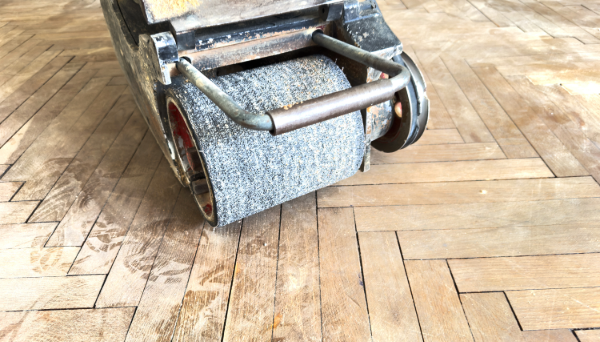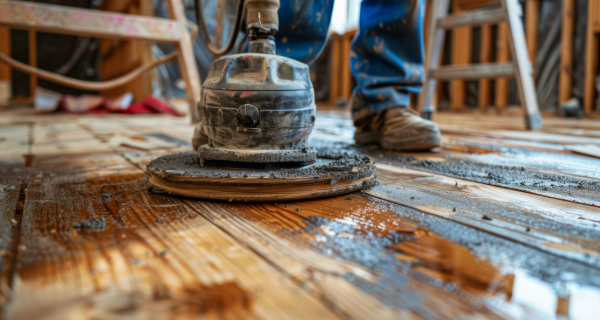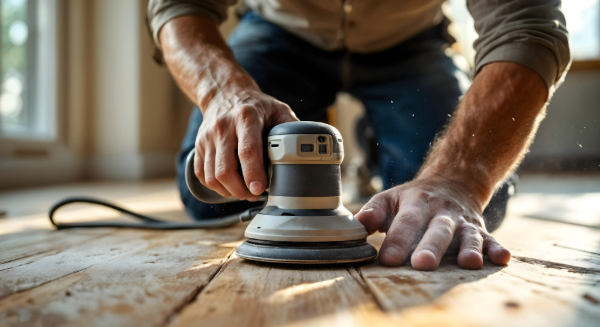When your hardwood floors start to show signs of wear, the question arises: Should you recoat, refinish, or replace them? The answer depends on the floor’s condition, budget, and desired outcome. Recoating is great if your floors are looking dull or have surface scratches. Refinishing is often the best option for floors with scratches, water damage, discoloration, or a worn finish. However, full replacement is more suitable when dealing with extensive damage like deep gouges, unrepairable damage, or structural issues that refinishing cannot fix.
In this guide, we’ll break down the key factors to help you make the most informed decision for your home. We’ll explore when each option is appropriate, compare costs and timelines, and highlight how each approach can transform your space—whether through restoration or a brand-new look.
When to Choose Recoating or Refinishing
Recoating is the process of giving a hardwood floor a new finish without sanding down the surface. The topcoat of the existing floor surface is thoroughly cleaned and lightly screened. A fresh coat of finish is then applied revitalizing the sheen and removing minor surface discolorations and scuffing. This process extends the life of your finished floors, keeping the finish from wearing all the way through to the wood, which prevents more costly damage.
Refinishing a hardwood floor involves a much more extensive process. During refinishing, your old finish is completely sanded down, revealing a fresh layer of hardwood. During this process, many of the deeper scratches, stains, and other damage are removed as well as any hand scraping, hit skip, rustic, and distressed character. Following the extensive sanding process several new coats of finish are applied to the hardwood. This is a more costly alternative to properly maintained floors.
Recoating or refinishing is an effective way to restore the beauty of hardwood floors that have experienced wear and tear. We will walk you through the process and each scenario below.
Ideal Scenarios for Recoating Hardwood Floors
If your wood floors are looking dull, it might be time for a recoat. Recoating is typically done before refinishing. We recommend recoating every 3 to 5 years for floors that have become mildly scratched or dull. Overall you will save time and money, preserving the excellence of your hardwood floor with recoating.
Recoating is recommended when the floor is structurally sound but has visible signs of age, such as:
- Light surface scratches or scuffs from foot traffic.
- Fading or dulling due to sun exposure over time.
- Floors that have lost their original luster, and do not show deep gouges or water stains.
Benefits of Recoating
- It preserves the original floor color and texture.
- It rejuvenates the flooring to look fresh and new again.
- Minimally invasive: Recoating your floors is not too disruptive to your home and busy lives.
Ideal Scenarios for Refinishing Hardwood Floors
Refinishing is recommended when the floor is structurally sound but has visible signs of age, and or damage such as:
- Major scratches or gouges with significant wear and tear.
- Water damage or stains.
- Instances where you want or need to lace in matching flooring and have it all look the same. Examples of this are adding hardwood flooring to the adjacent rooms, repairing damaged flooring, and lacing in matching material in the current areas.
For homeowners who want to preserve their existing hardwood, refinishing is a cost-effective way to avoid a full replacement. Floors made from solid hardwood or high-quality engineered hardwood floors can typically withstand multiple refinishing cycles, depending on their thickness. This option allows you to retain the natural charm of your floor while choosing a new color and/or finish.
Benefits of Refinishing
- Preserve the original floor: Refinishing maintains the wood species and character of your current floor.
- Eco-friendly and cost-efficient: By refinishing instead of replacing, you save on materials and avoid waste. This approach aligns with sustainable practices and is less expensive than a full replacement.
- New look, minimal hassle: A refinishing job can offer a completely new look without the need for demolition. You can even switch to a different color, or finish, such as satin or matte to match evolving design trends and update your space.
Proper care and maintenance are important, especially for homeowners who want to extend the life of their existing hardwood floors. If your current flooring still has life in it, choosing to recoat or refinish can be the best option to enhance both the beauty and durability of your wood flooring for years to come.
When Replacement is the Better Option
While recoating or refinishing can breathe new life into floors, some situations require a complete replacement to achieve the desired results. Replacement is the right choice when the existing flooring has sustained significant damage or when homeowners want to change the style, structure, or layout of the floor entirely.
Additionally, it is important to keep in mind that some floors cannot be refinished and will need to be replaced depending on the wear layer. Most of our engineered flooring at VANTIA has the same wear layer as solid flooring and can be refinished. However, most engineered flooring on the market cannot be refinished, making it disposable.
Replacement Scenarios
Certain types of damage or structural issues go beyond what the refinishing process can repair. Here are some common signs that indicate replacement may be the best route:
- Major water damage: If the floorboards have warped, buckled, or rotted due to prolonged exposure to water, sanding and refinishing will not be sufficient.
- Structural issues: An uneven subfloor or areas with noticeable dips and creaks suggest deeper problems that need to be addressed through replacement.
- Extensive damage: Deep gouges, heavy wear, or cracks across large sections of the floor indicate that the wood has reached the end of its lifespan.
Replacement is also ideal when homeowners are looking for a new aesthetic, such as switching to wider planks or installing a different type of wood altogether. This process offers the opportunity to incorporate modern styles, such as wide plank European oak flooring, which can transform the entire look of a room.
Benefits of Replacement
- Structural improvements: A new floor allows for correcting uneven surfaces and the ability to repair the subfloor if needed.
- Updated design options: Replacement opens the door to new trends, like wide planks or prefinished hardwood flooring, creating a modern and luxurious feel.
- Durability and longevity: With high-quality materials, the new floor will likely last for decades with proper maintenance.
Although replacing hardwood flooring involves higher upfront costs and more labor compared to refinishing, it can be the best option for achieving a completely new look and ensuring long-term performance. VANTIA Hardwoods specializes in full-service installation, offering a variety of premium materials to suit different styles and needs. Whether replacing an old floor that has sustained structural damage or upgrading to luxury engineered wood floors, this approach ensures both beauty and functionality in your home for years to come.
Cost and Time Considerations
Deciding whether to recoat, refinish, or replace hardwood floors often comes down to the costs involved and the time required to complete the project. Each option has its own financial and logistical considerations, so understanding these factors can help homeowners make a more informed decision.
Comparing Costs
If a recoat is an option for your flooring, it will be the most cost-effective option and give your flooring a facelift without breaking the bank.
Refinishing is generally more cost-effective than a full replacement. On average, refinishing costs less per square foot than purchasing and installing a new floor. However, the total cost of refinishing can vary depending on the condition of the floor and the number of finish coats required.
In contrast, replacing a floor involves additional expenses, such as the removal and disposal of the existing floor, the cost of new flooring material, and labor to install the new flooring. Of course, this cost can vary depending on the flooring you choose for replacement.
Time Investment
Recoating or refinishing typically takes less time than a full replacement. Depending on the size of the area, refinishing can be completed within a few days, including furniture removal, sanding, staining, and drying / curing phases. However, the space may need to remain off-limits for a day or two to allow the finish to cure properly. A refinish is nearly dustless, but can disrupt a home and the rooms will need to be blocked off and protected during this time.
Replacement projects can be more time-intensive. This includes furniture removal, demoing the existing floor and baseboard, preparing the subfloor, installing the new planks, and baseboards, and applying any necessary finishes or final coats. Most of the prefinished flooring on the market is ready to move back on immediately after the installation and does not require a final coat of finish. The timeline may also be extended if there are underlying structural issues to address or if complex designs, such as herringbone or chevron patterns, are part of the installation.
Additional Factors
Square footage plays a significant role in both cost and time. Larger areas naturally require more materials and labor, whether you choose to refinish or replace. Additionally, the choice between solid hardwood and engineered hardwood can affect the total investment. While both options offer durability, solid hardwood may be more expensive because you have to finish it on-site, whereas choosing a prefinished floor can have the same lifespan as solid flooring without requiring a finish. You can see those options here on our in stock hardwood flooring page.
Considering these financial and logistical elements will help homeowners determine the best course of action. Those looking for a quick refresh may find a recoat to be the most practical solution, while a full refinish or replacement can be a better option for those seeking long-term upgrades or structural improvements. Making the right decision upfront ensures the project stays within budget and on schedule while delivering the desired results for your home.

Pros and Cons of Refinishing vs. Replacing
Both refinishing and replacing hardwood floors offer distinct benefits and challenges, and understanding the pros and cons of each option is essential for making the right decision. Homeowners should consider the current state of their floors as well as their long-term goals, aesthetics, and budget when evaluating these options.
Pros of Refinishing
- Preserves existing materials: Refinishing allows you to maintain the original character of the floor, which is ideal if you love the look of the wood species already in place.
- Lower cost: Refinishing is typically more affordable than replacement, as it involves less labor and fewer materials.
- Eco-friendly option: Refinishing reduces waste and aligns with sustainable home improvement practices.
Cons of Refinishing
- Limited by floor condition: Refinishing only works for floors that are structurally sound and free from significant damage. Floors with water damage or deep gouges may not be suitable for this process.
- Cannot change layout or structure: Refinishing maintains the current look and structure of the floor, limiting design flexibility. We can add flooring to other areas, i.e., change the layout.
- Dust and inconvenience: Sanding creates dust, and the space must remain off-limits during the process to allow the finish to dry and cure properly.
- Lose any texture or bevel: If your floor has a dramatic texture like, boot scrape, saw marks, or wire brush, those will all be gone after the refinish.
Pros of Replacing
- Complete design freedom: Replacement allows you to choose a new style, wood species, or plank width to match current trends or personal preferences.
- Correct structural issues: If your old floor has uneven sections or underlying subfloor problems, replacement provides the opportunity to address these issues.
- Increased longevity: New floors, especially those made from durable materials, can last for decades with proper care and maintenance.
- Add areas: Starting fresh allows you to add areas you might want hardwood flooring that did not have hardwood to begin with.
Cons of Replacing
- Higher cost: Replacing a floor requires more labor and materials, including the removal of the existing floor and installation of new planks, which can drive up costs.
- Time-consuming: Replacement takes longer than refinishing, especially if additional work, such as subfloor repairs, is needed.
- More environmental impact: Although new materials can enhance the space, replacing floors results in more waste and resource consumption compared to refinishing.
Ultimately, the decision between refinishing and replacing hinges on your priorities. Refinishing is a smart choice when your floor has minor wear and you want to retain the original look, while replacement offers more flexibility for those looking to correct structural problems or embrace a new design. Balancing these pros and cons ensures homeowners make a choice that fits their budget and vision for their space.

How VANTIA Hardwoods Can Help You Make the Right Decision
Choosing between recoating, refinishing, or replacing your hardwood floors can feel overwhelming, but partnering with experts ensures you get the best outcome for your space. Whether you want to restore the natural beauty of your current floors or install new flooring, VANTIA Hardwoods & Interiors offers comprehensive services to meet your needs.
VANTIA Hardwoods specializes in recoating, refinishing, and replacement services, allowing homeowners to explore the full range of options. If your floors have minor scratches or a dull finish, VANTIA can bring them back to life and give you a free consultation to advise which process is best for your floors and budget. Our company’s skilled professionals ensure that the recoating or refinishing process enhances the durability and aesthetics of your floors, extending their lifespan without requiring replacement.
For homeowners dealing with extensive damage or structural issues, VANTIA offers full-service floor replacement. From removing the old floor to installing new planks and finishes, our team manages the entire process with precision. Whether you prefer wide plank flooring, reclaimed, or custom designs, VANTIA provides a curated selection of high-end solid or engineered hardwood flooring to suit your style and needs. With sustainable sourcing practices, the company ensures that every new floor installation combines beauty with eco-conscious values.
By working with VANTIA Hardwoods & Interiors, you gain access to experts who will guide you through the decision-making process, helping you evaluate the condition of your existing floors and choose the right path forward. Our team provides clear cost estimates, professional consultations, and meticulous craftsmanship to ensure that your investment adds long-term value to your home.
Whether you opt for a recoat or refinish to refresh your existing floors or a full replacement for a completely new look, VANTIA Hardwoods delivers superior results. Contact VANTIA today to schedule a consultation and explore how their refinishing and replacement services can transform your space into something truly exceptional.
